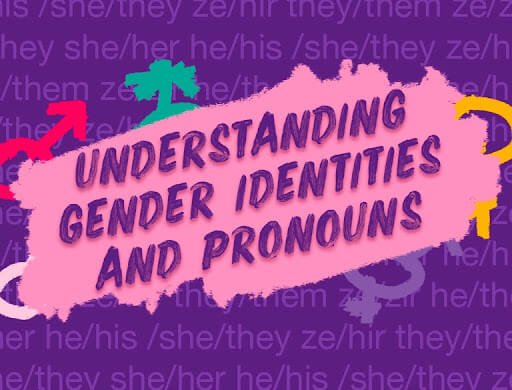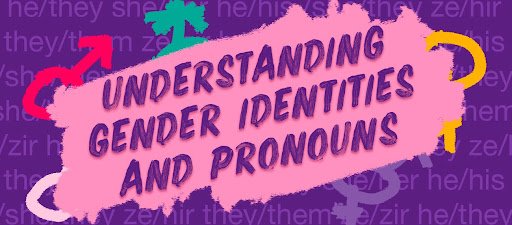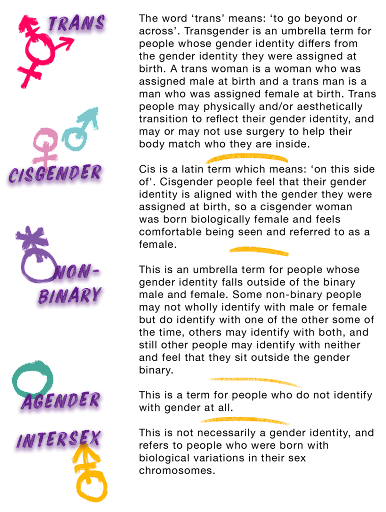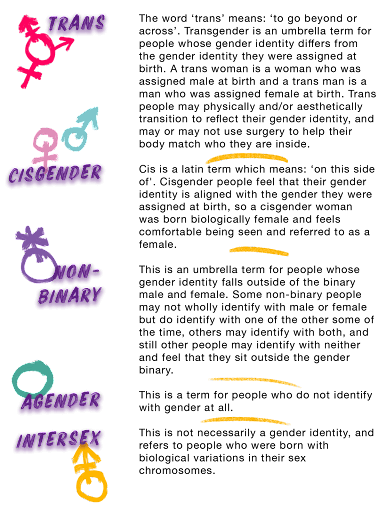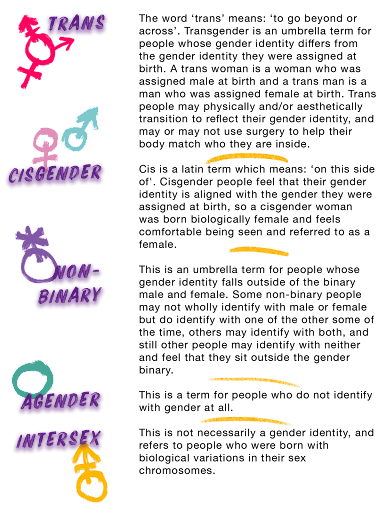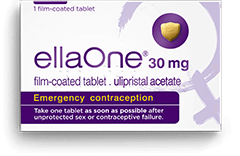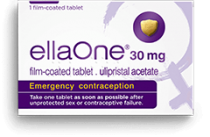Understanding gender identities and pronouns
Do you remember what a pronoun actually is? Pronouns are words that are substituted for nouns (naming words) which are used when the person you’re talking to already knows what you’re talking about. For example, “I have a sister. She is 27”. In the second part of this sentence we used the pronoun ‘she’ because it was obvious who we were referring to.
“‘Personal pronouns’ are words we can use to refer to another person besides their name,” says career coach Dr. Kyle Elliott* (he/him/his). “Common pronouns include, but are not limited to, ‘she/her/hers’, ‘he/him/his’, and ‘they/them/theirs.’”
This is essentially all pronouns are: ways of identifying who we are talking about without having to repeat it all the time.
What gender identity is, and how is it different to biological sex?
“Sex assigned at birth is a determination made by a medical professional about one’s physical body when they are born based on the perception of one’s genitals,” says Madison McCullough, a queer psychotherapist and clinical supervisor.* “Gender identity is someone’s internal experience and awareness of their relationships to masculinity and femininity, which may or may not be consistent with the sex they were assigned at birth.”
Why are pronouns important?
“Correct pronoun usage is integral to validating a person’s gender identity,” says Madison McCullough. “It is especially crucial for transgender and non-binary individuals, as this validation can significantly reduce the risk of experiencing gender dysphoria and associated mental health issues. By using the right pronouns, we send a powerful message that their identity is not only accepted but celebrated.”
Pronouns that you are likely to come in contact with include (but are not limited to):
-
- She/Her: These are typically used by individuals who identify as women.
- He/Him: These are commonly used by individuals who identify as men.
- They/Them: These are commonly used by people who are non-binary and do not exclusively identify as male or female. Some people may choose to alternate or accept both gendered pronouns and non-gendered pronouns, e.g. she/they or they/he, whilst others may only use ‘they/them’ pronouns.
- Some people may choose other gender-neutral pronouns, such as ze/zir or xe/xem. If you’re not sure which pronouns someone would like to be referred to as, it’s often a good idea to ask.
“It’s important to start by centring the fact that using the right pronouns is a way to demonstrate care and respect for another person,” says Madison McCullough. “The most common resistance I’ve seen come up around people using they/them/theirs pronouns is that people express not being used to using it in the singular. We use singular they/them/theirs all the time in our regular conversations! For example, ‘I went to the dentist and they told me to floss more.’ That’s a singular they, and it is truly not that hard – especially if someone is telling you that making this change would have a huge impact on their emotional wellbeing. It’s okay if it takes a while to adjust to, but it’s the trying that counts.”
Anything you’re not used to can sometimes feel uncomfortable and a little confusing at first. Some people may either disagree with the concept of gender not being binary altogether or may feel put upon to use language in a way that they don’t feel is ‘right’. These people might try to see the world from the other person’s point of view.
“Just like people are entitled to have the people they interact with call them by their name, people are entitled to be referred to in a way that affirms who they are,” says Madison McCullough. “People can experience gender dysphoria and real emotional harm when someone mis-pronouns them. When we use the correct pronouns for someone, it communicates that we see them as they wish to be seen, and that we respect their personhood. It communicates that their identity is as valid as anyone else’s, and that we take their gender identity seriously.”
Common misconceptions about gender and pronouns
Imagine your name is Francesca and you decide that you prefer to be called ‘Cesca’ rather than ‘Fran’ or your full name. You ask people to call you Cesca and most do – although some forget now and again and either correct themselves or you have to correct them – but there’s this one person who refuses. This person says they’re refusing because it’s too hard for them to remember the name you like to be called – because it’s not the name that they’ve always known you by and they don’t think you look like a Cesca.
Does this person have the right to refuse to call you by your chosen name because they can’t be bothered? Obviously gender and gender neutral pronouns carry more weight than this example as some people live with very real gender dysphoria which can be incredibly painful – but the point we are trying to make is that you get to decide how people refer to you, and it just seems a bit rude and petty for someone to refuse.
“The biggest misconception I’ve encountered around pronouns is a belief – especially around people who use they/them/theirs – that they’re being “sensitive” and asking for too much,” says Madison McCullough. “I would ask any cisgender person what it might feel like if they spent a whole day being referred to by the wrong pronouns. What would you imagine others might be thinking about you? How might you imagine others were perceiving you? Undoubtedly, it would at the very least confuse you, and potentially cause you emotional harm. This is what trans people and anyone whose gender identity is not 100% consistent with their sex assigned at birth navigate through. It’s really just about extending kindness and empathy.”
“You get to choose the pronouns that you use for yourself, and yourself only, and that is where your choice ends,” Dr. Kyle Elliott adds. “You don’t get to choose the pronouns other people use, even if you disagree with them.”
How to learn more about pronouns
You can’t be blamed for not knowing something you don’t know, or for being confused by things which are not in your lived experience. It’s also important, however, to remember that it’s not the job of trans and non-binary people to educate you on their identity.
People are people, and while some may be happy to explain how they see the world, they are not Wikipedia and it can be exhausting to be expected to not only justify your identity and existence but to also educate other people about it.
“You don’t need to have all the answers,” says Dr. Kyle Elliott. “In fact, it’s impossible to have all the questions. When in doubt, ask questions, rather than make assumptions. At the same time, don’t expect someone else to do all your education for you. There are a plethora of educational materials available from high-quality resources if you want to learn more about how to be a thoughtful, considerate, inclusive human. Please don’t expect yourself to get it right the first time. Language is constantly changing and evolving. Be open to getting corrected and constantly learning. If you mess up someone’s pronouns, apologise, own your mistake, and move forward.”
It can feel awkward if you assume someone’s gender or get their pronouns wrong, and it’s great that you want to avoid embarrassing or upsetting anyone. At the same time, drawing attention to it and going on about it can be more about you trying to feel better than about the other person, and could make things a lot worse. We’re human, we’re fallible and we make mistakes. It’s just important for us to be aware of when we do, and to remember to try and do things differently moving forward.
*The healthcare professionals featured in this article do not endorse any products or brands.
ellaOne® 30mg film-coated tablet contains ulipristal acetate and is indicated for emergency contraception within 120 hours (5 days) of unprotected sexual intercourse or contraceptive failure.
